I'm trying to put my company logo on the right corner of my html document
Here my code:
<script>
$(document).ready(function() {
$head = $('#header');
$head.prepend('<div class="knitr source"><img src="logo.png" width="220px" align="right" ></div>')
});
</script>
---
title: "Title"
author: "Author"
date: "Date"
theme: bootstrap
output: html_document
keep_md: true
---
```{r echo=FALSE, include=FALSE}
knitr::include_graphics('./logo.png')
```
<br>
## 1) Header
<br>
Lorem ipsum dolor sit amet, consectetuer adipiscing elit. Aenean commodo ligula eget dolor. Aenean massa. Cum sociis natoque penatibus et magnis dis parturient montes, nascetur ridiculus mus. Donec quam felis, ultricies nec, pellentesque eu, pretium quis, sem. Nulla consequat massa quis enim. Donec pede justo, fringilla vel, aliquet nec, vulputate eget, arcu. In enim justo, rhoncus ut, imperdiet a, venenatis vitae, justo.
However, because the logo.png is a local file when sharing the html document people are not able to see it.
Additionally, I tried the following approach
---
title: "Title"
author: "Author"
date: "Date"
output:
html_document:
css: markdown.css
includes:
in_header: extLogo.html
---
where extLogo.html
<div class="logos"><img src="logo.png" width="220px" align="right"></div>
But it creates a div outside the div where the Title is (<div class="container-fluid main-container">). Can anyone help on this?
